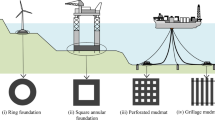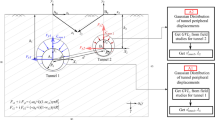Abstract
This paper is concerned with the hydroelastic problem of a very large pontoon-type floating structure (VLFS) edged with a pair of submerged horizontal plates, which is a combination of perforated and non-perforated plates attached to the for-end and back-end of the VLFS. For the hydroelastic analysis, the fluid is assumed to be ideal and its motion is irrotational so that a velocity potential exists. The VLFS is modeled as an elastic plate according to the classical thin plate theory. The fluid-structure interaction problem is separated into conventional hydrodynamics and structure dynamics by using modal expansion method in the frequency-domain. It involves, firstly, the deflection of the VLFS, which is expressed by a superposition of modal functions and corresponding modal amplitudes. Then the boundary element method is used to solve the integral equations of diffraction and radiation on the body surface for the velocity potential, whereas the vibration equation is solved by the Galerkin’s method for modal amplitudes, and then the deflection is obtained by the sum of multiplying modal functions with modal amplitudes. This study examines the effects of the width and location of the non-perforated horizontal plates on the hydroelastic response of the VLFS, then the performance of perforated plates is investigated to reduce the motion near the fore-end of the VLFS. Considering the advantages and disadvantages of submerged plates without and with cylindrical holes, we propose a simple anti-motion device, which is a combination of a pair of perforated and non-perforated plates attached to the for-end and back-end of the VLFS. The effectiveness of this device in reducing the deformation and bending moment of the VLFS has been confirmed, and is compared with the results in cases without and with the submerged horizontal plates by the analysis in this paper.
Similar content being viewed by others
References
Bishop, R. E. D., Price, W. G., and Temarel, P., 1986. A general linear hydroelasticity theory of floating structures moving in a seaway. Philosophical Transaction of the Royal Society of London (Series A), 316: 375–426.
Eatock Taylor, R., 2003. Wet and dry modes in linear hydroelasticity — why modes? Proceedings of 3rd International Conference on Hydroelasticity in Marine Technology. Oxford, UK, 239–250.
Eatock Taylor, R., and Ohkusu, M., 2000. Green functions for hydroelastic analysis of vibrating free-free beams and plates, Applied Ocean Research, 22: 295–314.
Fujikubo, M., Yao, T., and Oida, H., 1997. Dynamic response analysis of very large floating structures in waves using one-dimensional finite element mode. OMAE’97, 6: 107–114.
Gao, R. P., Tay, Z. Y., Wang, C. M., and Koh, C. G., 2011. Hydroelastic response of very large floating structure with a flexible line connection. Ocean Engineering, 38: 1957–1966.
Hong, D. C., and Hong, S. Y., 2007. Hydroelastic responses and drift forces of a very-long floating structure equipped with a pin-connected oscillating-water-column breakwater system. Ocean Engineering, 34: 696–708.
John, F., 1950. On the motion of floating bodies. Communications on Pure and Applied Mathematics, 3: 45–101.
Karmakar, D., and Guedes Soares, C., 2012. Scattering of gravity waves by a moored finite floating elastic plate. Applied Ocean Research, 34: 135–149.
Kashiwagi, M., 1999. Research on hydroelastic responses of VLFS: Recent progress and future work. International Society of Offshore and Polar Engineering, 4: 123–153.
Kim, B. W., Hong, S. T., Kyoung, J. H., and Cho, S. K., 2007. Evaluation of bending moments and shear forces at unit connections of very large floating structures using hydroelastic and rigid body analyses. Ocean Engineering, 34: 1668–1679.
Li, P. L., Shyu, R. G., Wang, W. H., and Cheng, C. Y., 2011. Analysis and reversal of dry and hydroelastic vibration modes of stiffened plates. Ocean Engineering, 38: 1014–1026.
Maeda, H., Masuda, K., Miyajima, S., and Ikoma, T., 1995. Hydrielastic reponses of pontoon type very large floating offshore structure. Journal of the Society of Naval Architects of Japan, 178: 203–212.
Newman, J. N., 1994. Waves effects on deformable bodies. Applied Ocean Research, 16(1): 47–59.
Pham, D. C., Wang, C. M., and Utsunomiya, T., 2008. Hydroelastic analysis of pontoon-type circular VLFS with an attached submerged plate. Applied Ocean Research, 30: 287–296.
Price, W. G., and Wu, Y. S., 1985. Hydroelasticity of marine structures. In: The 16th international Congress of Theoretical and Applied Mechanics. Lyngby, Denmark, 311–337.
Riyansyah, M., Wang, C. M., and Choo, Y. S., 2010. Connection design for two-floating beam system for minimum hydroelastic response. Marine Structures, 23: 67–87.
Takagi, K., Shimada, K., and Ikebuchi, T., 2000. An anti-motion device for a very large floating structure. Marine Structure, 13: 421–436.
Tay, Z. Y., Wang, C. D., and Wang, C. M., 2007. Hydroelastic response of a box-like floating fuel storage module modeled using non-conforming quadratic-serendipity Mindlin plate element. Engineering Structures, 29: 3503–3514.
Teng, B., and Gou, Y., 2006. Hydroelastic analysis of very large floating structure in frequency domain. Engineering Mechanics, 23(2): 36–48.
Watanabe, E., Utsunomiya, T., and Kuramoto, M., 2003. Wave response of analysis of VLFS with an attached submerged plate. International Journal of Offshore and Polar Engineering, 13(3): 190–197.
Watanabe, E., Utsunomiya, T., Wang, C. M., and Hang, L. T. T., 2006. Benchmark hydroelastic responses of a circular VLFS under wave action. Engineering Structures, 28: 423–430.
Wu, Y. S., 1984. Hydroelasticity of floating bodies. PhD thesis. Brunel University, UK.
Yan, H. M., Cui, W. C., and Liu, Y. Z., 2003. Hydroelastic analysis of very large floating structures using plate green functions. China Ocean Engineering, 17(2): 151–162.
Zhao, C. B., Liang, R. F., and Wang, H. L., 2008. Influence of the external loading conditions on the hydroelastic response of floating elastic plates. Applied Ocean Research, 30: 62–71.
Author information
Authors and Affiliations
Corresponding author
Rights and permissions
About this article
Cite this article
Ma, Z., Cheng, Y., Zhai, G. et al. Hydroelastic analysis of a very large floating structure edged with a pair of submerged horizontal plates. J. Ocean Univ. China 14, 228–236 (2015). https://doi.org/10.1007/s11802-015-2405-7
Received:
Revised:
Accepted:
Published:
Issue Date:
DOI: https://doi.org/10.1007/s11802-015-2405-7




